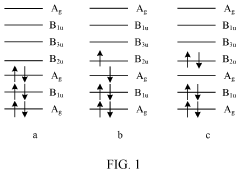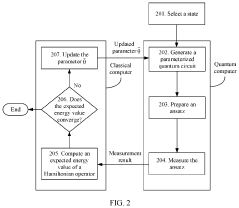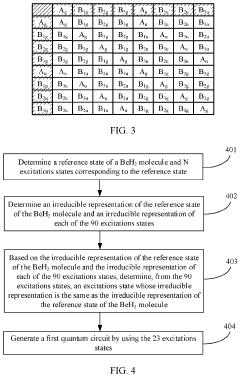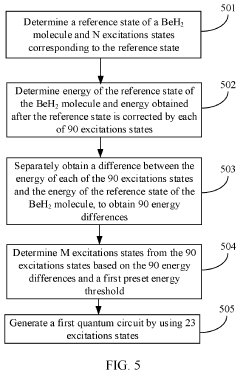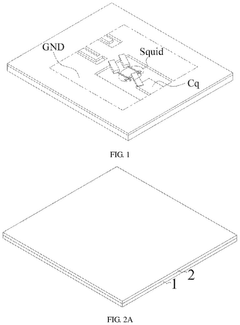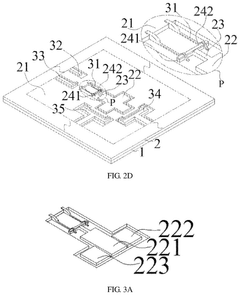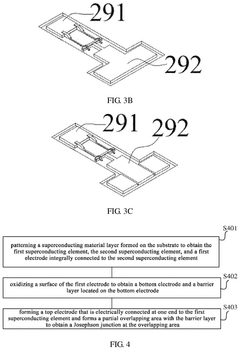Quantum Computing and its Innovation in Chemical Engineering Processes
JUL 17, 20259 MIN READ
Generate Your Research Report Instantly with AI Agent
Patsnap Eureka helps you evaluate technical feasibility & market potential.
Quantum Computing in Chemical Engineering: Background and Objectives
Quantum computing represents a revolutionary paradigm in computational technology, leveraging the principles of quantum mechanics to perform complex calculations at unprecedented speeds. In the context of chemical engineering, this emerging field holds immense potential to transform various processes and methodologies. The evolution of quantum computing can be traced back to the early 1980s when physicists first proposed the concept of quantum-based computation.
Over the past four decades, quantum computing has progressed from theoretical concepts to practical implementations, with significant milestones achieved in recent years. The development of quantum bits, or qubits, and quantum gates has paved the way for the creation of increasingly powerful quantum processors. This technological advancement has caught the attention of the chemical engineering community, recognizing its potential to address complex molecular simulations and optimization problems that are computationally intensive for classical computers.
The primary objective of integrating quantum computing into chemical engineering processes is to enhance the efficiency, accuracy, and scope of computational methods used in the field. This includes improving molecular simulations, optimizing chemical reactions, and accelerating drug discovery processes. By harnessing the power of quantum superposition and entanglement, researchers aim to model complex molecular systems with greater precision, potentially leading to breakthroughs in materials science, catalysis, and pharmaceutical development.
Another crucial goal is to overcome the limitations of classical computing in handling exponentially scaling problems often encountered in chemical engineering. Quantum algorithms, such as the quantum Fourier transform and quantum phase estimation, offer promising approaches to tackle these challenges. The ability to simulate quantum systems natively on quantum hardware opens up new avenues for understanding and manipulating matter at the atomic and molecular levels.
Furthermore, the integration of quantum computing in chemical engineering aims to drive innovation in process optimization and control. By leveraging quantum algorithms for optimization problems, engineers seek to enhance the efficiency of industrial processes, reduce energy consumption, and minimize waste production. This aligns with the broader objectives of sustainable development and green chemistry, where quantum computing could play a pivotal role in designing more environmentally friendly chemical processes.
As the field progresses, researchers are also focusing on developing hybrid quantum-classical algorithms that can leverage the strengths of both computing paradigms. This approach aims to create practical solutions that can be implemented in the near term, even as fully-fledged quantum computers continue to evolve. The ultimate vision is to establish quantum computing as an indispensable tool in the chemical engineer's arsenal, revolutionizing the way we approach complex chemical problems and driving innovation across the entire spectrum of chemical engineering applications.
Over the past four decades, quantum computing has progressed from theoretical concepts to practical implementations, with significant milestones achieved in recent years. The development of quantum bits, or qubits, and quantum gates has paved the way for the creation of increasingly powerful quantum processors. This technological advancement has caught the attention of the chemical engineering community, recognizing its potential to address complex molecular simulations and optimization problems that are computationally intensive for classical computers.
The primary objective of integrating quantum computing into chemical engineering processes is to enhance the efficiency, accuracy, and scope of computational methods used in the field. This includes improving molecular simulations, optimizing chemical reactions, and accelerating drug discovery processes. By harnessing the power of quantum superposition and entanglement, researchers aim to model complex molecular systems with greater precision, potentially leading to breakthroughs in materials science, catalysis, and pharmaceutical development.
Another crucial goal is to overcome the limitations of classical computing in handling exponentially scaling problems often encountered in chemical engineering. Quantum algorithms, such as the quantum Fourier transform and quantum phase estimation, offer promising approaches to tackle these challenges. The ability to simulate quantum systems natively on quantum hardware opens up new avenues for understanding and manipulating matter at the atomic and molecular levels.
Furthermore, the integration of quantum computing in chemical engineering aims to drive innovation in process optimization and control. By leveraging quantum algorithms for optimization problems, engineers seek to enhance the efficiency of industrial processes, reduce energy consumption, and minimize waste production. This aligns with the broader objectives of sustainable development and green chemistry, where quantum computing could play a pivotal role in designing more environmentally friendly chemical processes.
As the field progresses, researchers are also focusing on developing hybrid quantum-classical algorithms that can leverage the strengths of both computing paradigms. This approach aims to create practical solutions that can be implemented in the near term, even as fully-fledged quantum computers continue to evolve. The ultimate vision is to establish quantum computing as an indispensable tool in the chemical engineer's arsenal, revolutionizing the way we approach complex chemical problems and driving innovation across the entire spectrum of chemical engineering applications.
Market Demand for Quantum-Enhanced Chemical Processes
The market demand for quantum-enhanced chemical processes is rapidly growing as industries recognize the potential of quantum computing to revolutionize chemical engineering. This emerging technology promises to solve complex molecular simulations and optimization problems that are currently intractable for classical computers. The chemical industry, valued at over $5 trillion globally, is actively seeking innovative solutions to improve efficiency, reduce costs, and develop new materials.
Quantum computing offers significant advantages in molecular modeling, reaction pathway analysis, and process optimization. These capabilities are particularly valuable in drug discovery, materials science, and industrial chemical production. Pharmaceutical companies are investing heavily in quantum technologies to accelerate drug development processes, potentially reducing time-to-market and associated costs. The materials science sector is exploring quantum-enhanced simulations to design novel materials with specific properties, addressing demands in electronics, energy storage, and advanced manufacturing.
In the realm of industrial chemical production, quantum computing holds promise for optimizing complex chemical reactions and improving catalytic processes. This could lead to more energy-efficient manufacturing methods and reduced waste production, aligning with growing environmental concerns and sustainability goals. The potential for quantum computers to model and optimize entire chemical plants could result in substantial operational cost savings and increased productivity.
The market for quantum computing in chemistry is expected to grow significantly in the coming years. Major chemical and pharmaceutical companies are forming partnerships with quantum hardware and software providers to gain early access to this technology. Start-ups focusing on quantum algorithms for chemical simulations are attracting substantial venture capital, indicating strong market interest.
However, the adoption of quantum-enhanced chemical processes faces challenges. The technology is still in its early stages, with most quantum computers not yet powerful enough for large-scale industrial applications. There is a shortage of skilled professionals who can bridge the gap between quantum physics and chemical engineering. Additionally, the high cost of quantum hardware and the need for specialized software tools present barriers to widespread adoption.
Despite these challenges, the potential benefits of quantum computing in chemical engineering are driving continued investment and research. As quantum hardware capabilities improve and more industry-specific algorithms are developed, the market demand for quantum-enhanced chemical processes is expected to accelerate. This technology has the potential to create new market segments and disrupt traditional chemical engineering practices, making it a key area of focus for forward-thinking companies in the chemical sector.
Quantum computing offers significant advantages in molecular modeling, reaction pathway analysis, and process optimization. These capabilities are particularly valuable in drug discovery, materials science, and industrial chemical production. Pharmaceutical companies are investing heavily in quantum technologies to accelerate drug development processes, potentially reducing time-to-market and associated costs. The materials science sector is exploring quantum-enhanced simulations to design novel materials with specific properties, addressing demands in electronics, energy storage, and advanced manufacturing.
In the realm of industrial chemical production, quantum computing holds promise for optimizing complex chemical reactions and improving catalytic processes. This could lead to more energy-efficient manufacturing methods and reduced waste production, aligning with growing environmental concerns and sustainability goals. The potential for quantum computers to model and optimize entire chemical plants could result in substantial operational cost savings and increased productivity.
The market for quantum computing in chemistry is expected to grow significantly in the coming years. Major chemical and pharmaceutical companies are forming partnerships with quantum hardware and software providers to gain early access to this technology. Start-ups focusing on quantum algorithms for chemical simulations are attracting substantial venture capital, indicating strong market interest.
However, the adoption of quantum-enhanced chemical processes faces challenges. The technology is still in its early stages, with most quantum computers not yet powerful enough for large-scale industrial applications. There is a shortage of skilled professionals who can bridge the gap between quantum physics and chemical engineering. Additionally, the high cost of quantum hardware and the need for specialized software tools present barriers to widespread adoption.
Despite these challenges, the potential benefits of quantum computing in chemical engineering are driving continued investment and research. As quantum hardware capabilities improve and more industry-specific algorithms are developed, the market demand for quantum-enhanced chemical processes is expected to accelerate. This technology has the potential to create new market segments and disrupt traditional chemical engineering practices, making it a key area of focus for forward-thinking companies in the chemical sector.
Current State and Challenges in Quantum Chemical Simulations
Quantum chemical simulations have made significant strides in recent years, leveraging the power of quantum computing to tackle complex molecular systems. However, the field still faces numerous challenges that limit its widespread application in chemical engineering processes.
Currently, quantum chemical simulations can accurately model small to medium-sized molecules, providing insights into their electronic structure, reactivity, and spectroscopic properties. These simulations have proven valuable in drug discovery, materials science, and catalysis research. The advent of quantum algorithms, such as the variational quantum eigensolver (VQE) and quantum phase estimation (QPE), has enabled more efficient calculations of molecular properties on quantum hardware.
Despite these advancements, several key challenges persist. One major obstacle is the limited qubit count and coherence time of current quantum devices. This restricts the size and complexity of molecular systems that can be simulated accurately. Most quantum chemical simulations are still confined to simple molecules or require significant approximations for larger systems, limiting their practical applicability in industrial-scale chemical engineering processes.
Error correction remains a critical issue in quantum computing, affecting the reliability of quantum chemical simulations. While error mitigation techniques have been developed, they often come at the cost of increased computational overhead. This trade-off between accuracy and efficiency continues to be a significant challenge for researchers in the field.
The development of quantum algorithms tailored specifically for chemical simulations is another area of ongoing research. While existing algorithms have shown promise, there is a need for more robust and versatile approaches that can handle a wider range of chemical systems and properties. This includes algorithms for excited states, transition states, and dynamic processes, which are crucial for understanding many chemical reactions and phenomena.
Bridging the gap between quantum simulations and classical computational methods is also a key challenge. Hybrid quantum-classical algorithms have emerged as a potential solution, but optimizing the integration of these two paradigms remains an active area of research. Developing efficient methods for data exchange and workflow management between quantum and classical resources is crucial for practical applications in chemical engineering.
Scalability is another significant hurdle. As the complexity of chemical systems increases, so does the computational resources required for accurate simulations. Finding ways to scale quantum chemical simulations to industrially relevant systems while maintaining accuracy and efficiency is a major focus of current research efforts.
Currently, quantum chemical simulations can accurately model small to medium-sized molecules, providing insights into their electronic structure, reactivity, and spectroscopic properties. These simulations have proven valuable in drug discovery, materials science, and catalysis research. The advent of quantum algorithms, such as the variational quantum eigensolver (VQE) and quantum phase estimation (QPE), has enabled more efficient calculations of molecular properties on quantum hardware.
Despite these advancements, several key challenges persist. One major obstacle is the limited qubit count and coherence time of current quantum devices. This restricts the size and complexity of molecular systems that can be simulated accurately. Most quantum chemical simulations are still confined to simple molecules or require significant approximations for larger systems, limiting their practical applicability in industrial-scale chemical engineering processes.
Error correction remains a critical issue in quantum computing, affecting the reliability of quantum chemical simulations. While error mitigation techniques have been developed, they often come at the cost of increased computational overhead. This trade-off between accuracy and efficiency continues to be a significant challenge for researchers in the field.
The development of quantum algorithms tailored specifically for chemical simulations is another area of ongoing research. While existing algorithms have shown promise, there is a need for more robust and versatile approaches that can handle a wider range of chemical systems and properties. This includes algorithms for excited states, transition states, and dynamic processes, which are crucial for understanding many chemical reactions and phenomena.
Bridging the gap between quantum simulations and classical computational methods is also a key challenge. Hybrid quantum-classical algorithms have emerged as a potential solution, but optimizing the integration of these two paradigms remains an active area of research. Developing efficient methods for data exchange and workflow management between quantum and classical resources is crucial for practical applications in chemical engineering.
Scalability is another significant hurdle. As the complexity of chemical systems increases, so does the computational resources required for accurate simulations. Finding ways to scale quantum chemical simulations to industrially relevant systems while maintaining accuracy and efficiency is a major focus of current research efforts.
Existing Quantum Solutions for Chemical Process Optimization
01 Quantum Circuit Design and Optimization
This area focuses on developing and optimizing quantum circuits for various applications. It involves creating efficient quantum gate sequences, reducing circuit depth, and improving overall performance of quantum algorithms. Techniques may include circuit compression, qubit mapping, and error mitigation strategies to enhance the capabilities of quantum computers.- Quantum Computing Architectures: This category focuses on the design and implementation of quantum computing systems. It includes innovations in qubit arrangements, circuit layouts, and overall system architectures to improve quantum computation efficiency and scalability.
- Error Correction and Fault Tolerance: This area addresses the challenges of maintaining quantum coherence and mitigating errors in quantum systems. It encompasses techniques for error detection, correction, and fault-tolerant quantum computation to enhance the reliability of quantum operations.
- Quantum Algorithms and Applications: This category covers the development of quantum algorithms for various computational problems and their practical applications. It includes innovations in quantum simulation, optimization, machine learning, and cryptography that leverage the unique properties of quantum systems.
- Quantum-Classical Hybrid Systems: This area focuses on integrating quantum and classical computing technologies. It includes methods for interfacing quantum and classical systems, hybrid algorithms, and architectures that combine the strengths of both paradigms to solve complex computational problems.
- Quantum Hardware and Control Systems: This category encompasses innovations in quantum hardware components and control systems. It includes advancements in qubit technologies, quantum gates, readout mechanisms, and precise control systems for manipulating quantum states and performing quantum operations.
02 Quantum Error Correction and Fault Tolerance
Quantum error correction is crucial for maintaining the coherence of quantum states and mitigating the effects of noise and decoherence. This field encompasses the development of error-correcting codes, fault-tolerant quantum gates, and protocols for detecting and correcting errors in quantum systems. Advancements in this area are essential for building large-scale, reliable quantum computers.Expand Specific Solutions03 Quantum-Classical Hybrid Algorithms
Hybrid algorithms combine classical and quantum computing techniques to solve complex problems. This approach leverages the strengths of both classical and quantum systems, allowing for more efficient problem-solving in areas such as optimization, machine learning, and chemistry simulations. Hybrid algorithms are particularly useful in the near-term era of noisy intermediate-scale quantum (NISQ) devices.Expand Specific Solutions04 Quantum Hardware Architecture
This area focuses on the physical implementation of quantum computing systems, including the design of qubits, quantum processors, and supporting infrastructure. It encompasses various qubit technologies such as superconducting circuits, trapped ions, and topological qubits. Advancements in quantum hardware architecture aim to increase qubit coherence times, reduce error rates, and scale up the number of qubits in quantum systems.Expand Specific Solutions05 Quantum Software and Programming Languages
The development of quantum software and programming languages is essential for making quantum computing accessible to a wider range of users. This field includes the creation of high-level quantum programming languages, software development kits (SDKs), and tools for quantum algorithm design and simulation. These advancements aim to bridge the gap between quantum hardware and practical applications, enabling developers to harness the power of quantum computing more easily.Expand Specific Solutions
Key Players in Quantum Computing for Chemistry
The quantum computing landscape in chemical engineering processes is in an early developmental stage, characterized by significant research and investment but limited commercial applications. The market size is growing rapidly, with projections indicating substantial expansion in the coming years. Technological maturity varies across companies, with established tech giants like IBM, Google, and Huawei leading in quantum hardware development. Startups such as Zapata Computing and 1QB Information Technologies are focusing on quantum software solutions for chemical engineering applications. Academic institutions like Tsinghua University and Cornell University are contributing to fundamental research. The competition is intensifying as more players enter the field, driving innovation in both hardware and software aspects of quantum computing for chemical engineering processes.
Huawei Technologies Co., Ltd.
Technical Solution: Huawei is developing quantum computing solutions for chemical engineering processes, focusing on both hardware and software aspects. Their HiQ quantum computing cloud platform provides access to quantum simulators and real quantum devices for researchers and industry partners[6]. Huawei is working on developing quantum algorithms for molecular simulations and optimizing chemical reactions. They have partnered with academic institutions to advance quantum computing applications in materials science and drug discovery. Huawei's approach includes developing hybrid quantum-classical algorithms to leverage the strengths of both quantum and classical computing for solving complex chemical engineering problems.
Strengths: Strong integration of quantum computing with cloud infrastructure, focus on practical applications in chemical engineering. Weaknesses: Relatively new entrant in the quantum computing field compared to some competitors.
Google LLC
Technical Solution: Google's quantum computing efforts in chemical engineering focus on developing quantum algorithms for simulating molecular systems and optimizing chemical reactions. Their Sycamore processor, with 53 qubits, has demonstrated quantum supremacy[4]. Google is working on quantum error correction techniques to improve the stability of quantum computations for chemical simulations. They have developed the OpenFermion library, which allows seamless integration of quantum chemistry algorithms with their Cirq quantum programming framework[5]. Google has also demonstrated the ability to simulate small molecules and is working towards simulating more complex chemical systems relevant to industrial processes.
Strengths: Advanced quantum hardware, strong focus on error correction, and open-source tools for quantum chemistry simulations. Weaknesses: Limited commercial applications in chemical engineering processes to date.
Breakthrough Quantum Algorithms for Molecular Modeling
Quantum Circuit Generation Method and Related Device
PatentActiveUS20220269967A1
Innovation
- A method to determine a reduced set of excitations states based on irreducible representations and energy differences, generating a quantum circuit that reduces the depth and number of quantum gates, thereby improving computation efficiency and resource utilization.
Superconducting quantum circuit and fabrication method thereof, quantum computer
PatentPendingUS20240341202A1
Innovation
- A superconducting quantum circuit structure with a bottom electrode integrally connected to a second superconducting element and a top electrode forming a Josephson junction, allowing for synchronous patterning and reduced evaporation coating processes, facilitating efficient fabrication.
Environmental Impact of Quantum-Optimized Chemical Processes
The integration of quantum computing into chemical engineering processes has the potential to significantly reduce the environmental impact of these operations. Quantum-optimized chemical processes can lead to more efficient use of resources, lower energy consumption, and reduced waste generation, thereby contributing to a more sustainable chemical industry.
One of the primary environmental benefits of quantum-optimized chemical processes is the improvement in reaction efficiency. Quantum algorithms can simulate complex molecular interactions with unprecedented accuracy, allowing for the design of more selective and efficient catalysts. This enhanced selectivity can lead to higher yields of desired products while minimizing the formation of unwanted by-products. As a result, less raw material is wasted, and the need for energy-intensive separation processes is reduced.
Energy consumption is another area where quantum-optimized processes can have a substantial environmental impact. By leveraging quantum computing to optimize reaction conditions and process parameters, chemical plants can operate at lower temperatures and pressures. This reduction in energy requirements not only decreases the carbon footprint of chemical production but also lowers operational costs. Additionally, quantum-assisted optimization of heat integration and energy recovery systems within chemical plants can further enhance overall energy efficiency.
Quantum computing can also contribute to the development of more environmentally friendly chemical products. By enabling the accurate prediction of molecular properties and behaviors, quantum simulations can accelerate the discovery of new materials with improved environmental characteristics. This includes biodegradable polymers, non-toxic solvents, and more efficient catalysts for pollution control technologies.
In the realm of waste management, quantum-optimized processes can lead to significant improvements. By enhancing the precision of chemical reactions and separation processes, the volume of waste generated can be substantially reduced. Furthermore, quantum algorithms can be applied to optimize waste treatment processes, making them more effective at removing contaminants and potentially enabling the recovery of valuable resources from waste streams.
The application of quantum computing in process control and real-time optimization can lead to more stable and efficient plant operations. This stability translates to fewer unplanned shutdowns, reduced flaring events, and overall lower emissions. Quantum-enhanced sensors and monitoring systems can provide more accurate and timely data on process conditions, enabling proactive measures to prevent environmental incidents.
While the environmental benefits of quantum-optimized chemical processes are promising, it is important to consider the potential environmental impact of quantum computing infrastructure itself. As quantum technologies advance, efforts should be made to ensure that the energy consumption and resource requirements of quantum computers do not offset the environmental gains achieved in chemical processes.
One of the primary environmental benefits of quantum-optimized chemical processes is the improvement in reaction efficiency. Quantum algorithms can simulate complex molecular interactions with unprecedented accuracy, allowing for the design of more selective and efficient catalysts. This enhanced selectivity can lead to higher yields of desired products while minimizing the formation of unwanted by-products. As a result, less raw material is wasted, and the need for energy-intensive separation processes is reduced.
Energy consumption is another area where quantum-optimized processes can have a substantial environmental impact. By leveraging quantum computing to optimize reaction conditions and process parameters, chemical plants can operate at lower temperatures and pressures. This reduction in energy requirements not only decreases the carbon footprint of chemical production but also lowers operational costs. Additionally, quantum-assisted optimization of heat integration and energy recovery systems within chemical plants can further enhance overall energy efficiency.
Quantum computing can also contribute to the development of more environmentally friendly chemical products. By enabling the accurate prediction of molecular properties and behaviors, quantum simulations can accelerate the discovery of new materials with improved environmental characteristics. This includes biodegradable polymers, non-toxic solvents, and more efficient catalysts for pollution control technologies.
In the realm of waste management, quantum-optimized processes can lead to significant improvements. By enhancing the precision of chemical reactions and separation processes, the volume of waste generated can be substantially reduced. Furthermore, quantum algorithms can be applied to optimize waste treatment processes, making them more effective at removing contaminants and potentially enabling the recovery of valuable resources from waste streams.
The application of quantum computing in process control and real-time optimization can lead to more stable and efficient plant operations. This stability translates to fewer unplanned shutdowns, reduced flaring events, and overall lower emissions. Quantum-enhanced sensors and monitoring systems can provide more accurate and timely data on process conditions, enabling proactive measures to prevent environmental incidents.
While the environmental benefits of quantum-optimized chemical processes are promising, it is important to consider the potential environmental impact of quantum computing infrastructure itself. As quantum technologies advance, efforts should be made to ensure that the energy consumption and resource requirements of quantum computers do not offset the environmental gains achieved in chemical processes.
Quantum Computing Hardware Requirements for Chemistry Applications
Quantum computing hardware for chemistry applications requires specialized systems capable of manipulating quantum bits (qubits) to simulate complex molecular structures and chemical reactions. These systems must maintain quantum coherence for extended periods to perform meaningful calculations. Current quantum hardware platforms include superconducting circuits, trapped ions, and topological qubits, each with unique advantages and challenges.
Superconducting circuits, based on Josephson junctions, offer scalability and fast gate operations. However, they are sensitive to environmental noise and require extremely low temperatures (near absolute zero) to operate. This necessitates sophisticated cryogenic systems and shielding to maintain qubit stability.
Trapped ion systems use individual atoms as qubits, offering long coherence times and high-fidelity operations. These systems are less sensitive to environmental noise but face challenges in scaling up to large numbers of qubits. Precise laser control and ion trapping mechanisms are crucial for their operation.
Topological qubits, while still in early development, promise increased error resistance through their inherent physical properties. These systems require specialized materials and extreme conditions to create and manipulate quasiparticles like Majorana fermions.
For chemistry applications, quantum hardware must support a sufficient number of qubits with high fidelity and low error rates. Current estimates suggest that practical quantum advantage in chemistry simulations may require thousands of logical qubits, which translates to millions of physical qubits when accounting for error correction.
Quantum error correction is a critical requirement for chemistry applications, as chemical simulations often require long computation times. Hardware must support the implementation of error correction codes, such as surface codes, which demand additional physical qubits and complex control systems.
Connectivity between qubits is another crucial factor. Many chemistry algorithms require high connectivity between qubits, which can be challenging to achieve in physical hardware. Architectures that support flexible qubit interactions or all-to-all connectivity are particularly valuable for chemistry simulations.
As quantum hardware continues to evolve, hybrid quantum-classical systems are emerging as a promising approach. These systems combine quantum processors with classical computers to leverage the strengths of both paradigms. This hybrid approach may provide a practical path forward for near-term applications in computational chemistry.
Superconducting circuits, based on Josephson junctions, offer scalability and fast gate operations. However, they are sensitive to environmental noise and require extremely low temperatures (near absolute zero) to operate. This necessitates sophisticated cryogenic systems and shielding to maintain qubit stability.
Trapped ion systems use individual atoms as qubits, offering long coherence times and high-fidelity operations. These systems are less sensitive to environmental noise but face challenges in scaling up to large numbers of qubits. Precise laser control and ion trapping mechanisms are crucial for their operation.
Topological qubits, while still in early development, promise increased error resistance through their inherent physical properties. These systems require specialized materials and extreme conditions to create and manipulate quasiparticles like Majorana fermions.
For chemistry applications, quantum hardware must support a sufficient number of qubits with high fidelity and low error rates. Current estimates suggest that practical quantum advantage in chemistry simulations may require thousands of logical qubits, which translates to millions of physical qubits when accounting for error correction.
Quantum error correction is a critical requirement for chemistry applications, as chemical simulations often require long computation times. Hardware must support the implementation of error correction codes, such as surface codes, which demand additional physical qubits and complex control systems.
Connectivity between qubits is another crucial factor. Many chemistry algorithms require high connectivity between qubits, which can be challenging to achieve in physical hardware. Architectures that support flexible qubit interactions or all-to-all connectivity are particularly valuable for chemistry simulations.
As quantum hardware continues to evolve, hybrid quantum-classical systems are emerging as a promising approach. These systems combine quantum processors with classical computers to leverage the strengths of both paradigms. This hybrid approach may provide a practical path forward for near-term applications in computational chemistry.
Unlock deeper insights with Patsnap Eureka Quick Research — get a full tech report to explore trends and direct your research. Try now!
Generate Your Research Report Instantly with AI Agent
Supercharge your innovation with Patsnap Eureka AI Agent Platform!
